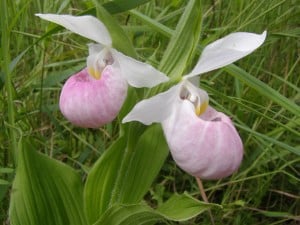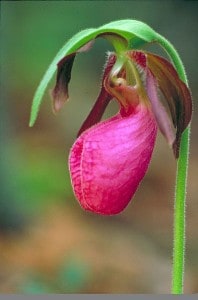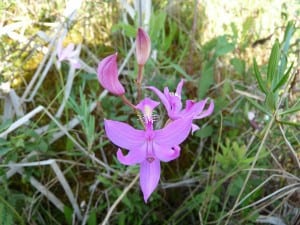For anyone with an interest in wildflowers, June is synonymous with orchids. At least a dozen species of this fascinating plant family bloom this month in the Kawarthas, and the spectacle is not to be missed. In addition to their exquisite colours and designs, orchids are a wonderful testament to the power and wonder of evolution.
The Kawarthas has long enjoyed a special status among orchid lovers. The first book on Ontario’s orchids was researched and written here by a Peterborough resident, Frank Morris, in 1929. Some of the most interesting passages are his vivid descriptions of orchid searching trips to the Cavan Swamp and Stony Lake. Unfortunately, one becomes immediately aware that orchids were much more plentiful at that time. Because of habitat loss, indiscriminate picking and digging up for transplanting into gardens, most orchid species have declined greatly in number. In fact, I recall that well-known naturalist Doug Sadler once told me that in the 1950s people used to sell bouquets of Showy Lady’s slippers at the Peterborough Farmers’ Market!
Peterborough County is home to about 36 orchid species including one, Helleborine, which is an alien species from Eurasia. Of the 36, 14 are considered rare or their presence is based on very old records. Species belonging to the genus Cypripedium, commonly known as lady’s slippers, are the most renowned of our orchids. The Kawarthas boast four species. Probably the best-known member of this genus is the Pink Lady’s slipper, also known as the Moccasin flower. It is usually found in dry, upland sites, quite often in association with pines. Petroglyphs Provincial Park and the north shore of Stony Lake provide good habitat for this species. The largest of our native orchids is the Showy Lady’s slipper which measures up to 80 cm in height and occurs in open to semi shaded wetland edges. This species requires 10 years of growth from germination to the time it flowers. Dry to moist calcium rich sites are the preferred habitat of the Yellow Lady’s slipper, possibly our most common member of the genus. This species is widespread in the Warsaw area. The Kawarthas also has good numbers of Ram’s head Lady’s slipper. They prefer cold, undisturbed wetland edges and are often found in association with White Cedars.
One reason I love orchids is that they have so much to tell us about evolution. They show amazing adaptations – or contrivances, as Charles Darwin described them – to attracting and exploiting their insect pollinators. In his book “Fertilization of Orchids”, Darwin explained in detail the complex relationships between these flowers and their pollinators and how this led to the co-evolution of both. He realized that as the insects changed, so did the orchids that were dependent upon them. And vice-versa. Darwin’s work provided the first detailed demonstration of the power of natural selection. Co-evolution between orchids and insects has led to an incredible amount of diversity. In fact, with close to 30,000 different species, orchids represent the world’s largest family of plants. They are also a very old family. The first orchids are believed to have appeared some 80 million years ago. This means that they may have co-existed with dinosaurs! Despite the huge number of species, most orchids tend to be uncommon and almost never dominate a given landscape. Paradoxically, they produce seeds in astronomical quantity well over a million in some species.
The Pink Lady’s-slipper, one of the more common local species, provides a great example of the complicated dance between orchid and pollinator. Its sweet odour and enticing pink pouch – a modified petal – attract bumblebees. On the hunt for nectar and pollen, these large, hairy insects pry their way into the large, slipper-like pouch through the incurved slit down the front. Once inside, the slit closes and traps the hapless bee. Exiting by where it entered therefore becomes impossible. But, it’s not all bad news. The upper part of the pouch is lined with sticky hairs coated in nectar, and there are translucent areas where light shines through. Attracted by the light and sugar reward, the bee climbs upwards to gather nectar and to make its escape. The pouch constricts, however, below two small exits to the outside. In order to regain its freedom, the bee must crawl under a large flattened structure. As it does so, the insect’s back rubs up against the stigma, the female part of the flower. Any pollen sticking to its body – presumably from another orchid it visited earlier – is scraped off. Bingo! The orchid is pollinated. But one last bit of trickery still remains. As the bee finally makes its way out of one of the strategically-located exit holes, it inadvertently rubs up against a sticky mass of pollen grains, which adheres to its back and sides. If it enters yet another Pink Lady’s-slipper, the bee will follow the same path and unwittingly leave behind pollen once again. In this manner, cross pollination between plants is assured.
Despite this elaborate pollination mechanism, Pink Lady’s slippers seem to spread mostly through their rhizomes. Rhizomes are underground, creeping stems that are capable of forming new plants. This explains why, unlike most other native orchids, Pink Lady’s-slippers are sometimes found in large masses.
Three other species are of considerable interest this month, both because of the unique design of their flowers and the special habitats in which they grow. They are the Arethusa (Dragon’s mouth), Calopogon (Grass pink) and Rose Pogonia (Snake mouth). All three are pink in colour and grow in the acid soil of bogs and wet meadows. All can be found in Kawartha Highlands Provincial Park. Pollination for these species, too, depends on some very clever adaptations. In the case of Calopogon, downright deception comes into play. Bees are immediately attracted to the top petal of the flower because of a mass of stamen like objects, which appear to be loaded with pollen. However, upon landing on these hairs, the insect quickly realizes there is no pollen to be found. But, before it can fly away, the bee’s weight causes the petal to collapse downward. The hapless bee ends up on its back, pinned against a trough like appendage that contains the true sexual parts of the flower. The bee’s hairy back may pick up sticky pollen located here or transfer pollen from a previous visit to another Calopogon to the stigma, thereby assuring pollination. Evolution rarely takes the easy route to solving the challenges of reproduction!
Orchids, like all plants, follow a definite blooming schedule. Most of the lady’s slippers bloom in late May through mid June. Showy lady’s slipper, however, along with Arethusa, Calopogon and Rose Pogonia, usually bloom in late June. Rose Pogonia can sometimes still be found in flower as late as mid July. Later in the summer, watch for Spotted Coral root (July), Dwarf Rattlesnake plantain (late July and August) and Nodding ladies’ tresses (late August and September). Once again, Petroglyphs Provincial Park is a good place to try for all three of these summer blooming species. Ladies’-tresses also grow in damp areas along the edge of the Trans-Canada Trail, just east of Highway 7.
It’s important to resist the temptation to dig orchids up and transplant them into your garden. Not only does this put the species further at risk, but it is rarely successful. Orchids depend on a special relationship with fungi, which provide the plants with minerals and other nutrients that they cannot attain by themselves. Without the presence of the right fungi in the soil, most orchids will not survive.


